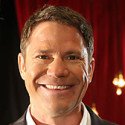Exclusive - Steve Backshall reveals all about his new ITV series Fierce
I was lucky enough to catch up with Steve Backshall to talk about his new ITV series, Fierce, which sees him seeking out some of the world’s most fierce animals. The series sees Steve taking part in six epic adventures in Guyana, Mexico, Namibia, Indonesia, Australia and South Africa. Fierce starts on Tuesday 19th April at 8pm on ITV.
How did the show come about on ITV?
I pitched this idea a year ago and the people at ITV were instantly very praising of it and they thought it was a different thing to be having on ITV. For me it is a real opportunity to be talking to a different audience because a lot of the time in the past I’ve been talking to a children’s audience mainly on BBC. Going out on primetime on a channel like ITV you are going to have a broader audience but all of those people are not going to be necessarily wildlife lovers. It is about finding a way in the material that has a more universal appeal and I think that is a challenge I was quite excited by.
Do you have any tricky situations that you have to deal with involving the fearsome animals you encounter?
Yeah the trickiest thing for me is always going to be finding them because it is wildlife and I always set out to do my programmes, hand on heart, absolutely real with nothing constructed and nothing set up. That does mean that for every minute you see me finding an animal there has been several days of searching to try and find it in the first place. That is the tough bit; it is doing the hard yards, yomping through deserts or rain forests as you desperately attempt to find that animal that you have gone out after.
How do you manage to keep yourself motivated when you need to deal with challenging climates as well?
The heat has been really overpowering on the trips we have done so far. It has been an overwhelming heat that has been really tough. For me the motivation is always knowing that it could be the next second that it happens. With wildlife you are always thinking I have been looking for two days and haven’t found anything but it could be under that next rock or it could be round this next corner. I have this positivity and optimism that it could be just around the next corner and that is the thing that keeps me motivated.
Is there real danger involved as you are searching for the different creatures?
A lot of what I do is making sure that it is not dangerous. I have been working with animals for a long, long time and I know what the limits are and I try not to push those limits and to stay well within them. The crews that I am used to dealing with are very much the same as they work with wildlife too. So we know what the rules are and we know what the limits are. A hefty proportion of what I do is working at night as in a lot of environments a lot of things come to life then. There are different challenges but not necessarily different dangers. In terms of my pain threshold it has been severely tested many times in the past so I have got a very high pain threshold and I hope not to have to test it anymore on this series.
How dangerous is it for the people living in the different places that you visit?
This is very difficult for a British audience to come to terms with and I hope this is really something people get out of these programmes. We British have this overpowering fear of the wild; we are convinced that in wild places everything is kind of out to get us! But in places where people live with crocodiles in a river at the bottom of their garden, or with the most venomous snakes and spiders they just don’t think that way. They have a totally different view of nature and wildlife. Statistics show there is no comparison in the level of risk if you live in place where there are five metre crocodiles in every single river compared to the dangers posed by the cars on the streets of London. The people who live amongst wildlife know what their limits are, they know what the rules are, they know how to live within those rules and they see it as being an inevitable consequence of living where they do.
It is quite refreshing as we meet people who have been bitten or been stung and they say, "I will make sure I don’t do that again!" They don’t hate the animals, they don’t want to destroy or get rid of them, they don’t overstate or over emphasise the danger like we do here in this country. We have become very detached from nature here and we have lost sense of what the reality of it is.
Is there anywhere in the world you haven’t been to yet that you really want to visit?
I have been to 105 countries but there are at least 216 in the world so I am not even half way there. Somewhere I desperately want to go to is the Karakoram in Pakistan. I have had two expeditions there which have been cancelled and I desperately hope that one day I will get the chance to go there.
Where is the favourite place you have visited so far?
On Fierce my favourite was Indonesia. We went to the Komodo National Park which is a really special place both above and below the water. Below the water you have this extradinary abundance of marine life in fabulous diversity. Many of the creatures, despite the fact that I have filmed there six or seven times, I’ve never seen before. On land you have got the world’s largest lizard, a three metre long dinosaur walking along the beaches. Yeah, it’s an incredible place.
If you film a second series what sort of animals will you be looking for and in what sort of regions?
I’ve been doing this for a long time now and I have a list as long as my arm of places are fantastic to go to for these kind of animals. I could do not just a second series but probably twenty series without any problems.
What amount of time do you get to spend in each of the locations?
Two weeks. For example in the Guyana programme, there is one big town called George Town, and then it was a charter flight of several hours and then a river journey of nine hours to get to where our base camp was. I sleep in a hammock at night but I am very used to that.
How did you first become involved in making wildlife programmes?
Well I was working as writer and I had an idea for a programme. I got myself a video camera and I went out and made it in Columbia. I just wandered around in the rain forest filming myself catching snakes, spiders and scorpions living rough. I sold it to National Geographic and they took me on as their adventurer in residence and that was in 1999 and I’ve been doing it ever since.
What tips would you give anyone who wants to follow in your footsteps?
I would start of by studying science, I would study biology and go on to study marine biology. I would study zoology at university and I would volunteer and work for every wildlife conservation charity that you can get hold of. More than anything though it is a state of mind, it is a state of inquisitive of wanting to find out everything about what you see outside in the natural world.
What was more scary coming face to face with dangerous animals or facing the judges when you appeared on Strictly Come Dancing?
The first week of Strictly was scary because I had never danced a step before and I genuinely didn’t know if I was going to humiliate myself in front of every person I had ever met. It is a big show and has a huge viewing audience in this country. After the first week where I knew where I was going to be, I knew I wasn’t going to be one of the ones competing to win it but I also knew I wasn’t going to be one of the people out in ignominy in week two, I enjoyed it. So it certainly wasn’t as scary as a hippo.
Have you ever been scared for your life whilst taking part in an expedition?
Yeah lots. It is very rarely from animals though, it’s things like rock fall, it’s things like weather. It’s very often people like coming back from a big expedition and being held up at gun point or having a car crash or being caught in a riot. People are so much frightening than animals could ever be.
- itv
Person:
- Steve Backshall
Show:
- Fierce
Apr 12th, 2016, 2:03 am
Images courtesy of itv
Next Article
New cast members for Broadchurch 3 announced ahead of filming of the final seriesPrevious Article
Episodes to end after season five
Strictly Come Dancing - Steve Backshall confirmed as taking part
Steve Backshall, best known for presenting wildlife shows, is the 9th..
Eighth Celebrity Eliminated From 'Strictly Come Dancing'
Following last week’s show which saw Judy Murray and her professional..

